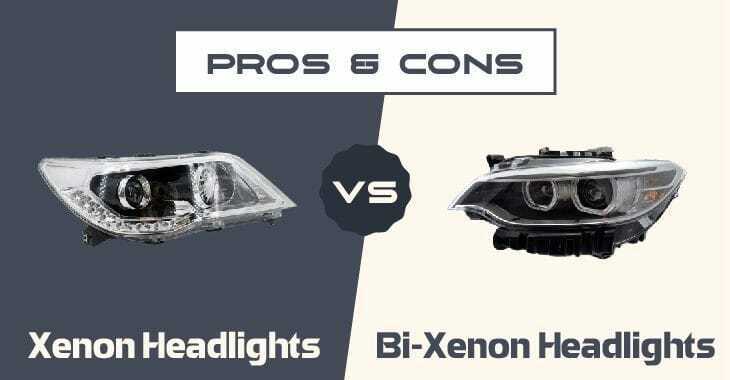by Joshua Thomas
Which is the right headlight for your car? Which one offers you the most value? Xenon or bi-Xenon headlights?
For many drivers, the Xenon technology is relatively new, and so bringing bi-Xenon bulbs into the pictures makes things more complicated.
Both technologies use Xenon bulbs in the car headlights, but the way the headlights get manufactured and how they function are both different.
The following side by side comparison takes a look at both headlight technologies and provides you with all the necessary information that you'll need when making a buying decision.
Contents

Photo: autocar.co.uk
Xenon bulbs, which are also called High-Intensity Discharge bulbs or HID, produce the whitest and brightest lights that get used in car headlights.
They first came to use in a 1991 7-Series BMW and have continued gaining popularity since then. Xenon bulbs take a few seconds to power up and this has limited their use in certain applications.
In addition to a delayed power-up, Xenon bulbs also get so bright that they'll immediately blind the drivers in oncoming vehicles when used as a high beam.
These reasons led to the use of Xenon bulbs as low beams and halogen bulbs as high beams. So most so-called Xenon headlights use a combination of halogen and Xenon bulbs to work.
It also makes sense because switching a Xenon high beam Off and On to avoid blinding an oncoming driver can get dangerous, since the Xenon bulb will need a few seconds to power back on, and many things could happen in this period.
With a halogen high beam, the danger of blinding oncoming motorists gets reduced and you get instant long-range vision once you switch on the high beam.
Although this solution is very helpful and welcomed by most drivers, it still uses halogen for the high beam, which creates a rather yellowish light that many find inferior to Xenon's day-like light.
Pros
Cons

Trying to solve the problems associated with Xenon bulbs as part of car headlights led to the bi-Xenon headlight system development.
With the bi-Xenon headlight system, a single Xenon bulb is used to carry out both high beam and low beams. This results in long-term cost savings, although a mechanical system is introduced into the headlight system.
The mechanical system can either be used to point the bulb upwards and downwards, or it can work to partially block and unblock it.
Each bulb's reflector can also be moved and this includes both vertically and sideways. Some cars even go further and automatically move the reflector sideways when the car is making a turn in that direction, allowing you to see better.
What this means is that there are no down times, once the Xenon bulb gets switched on. You flick a switch and the bulb's beam is immediately redirected in full brightness.
These features make the bi-Xenon technology interesting and with lots of potential for the future. One major downside though is the reliance on mechanical systems, which theoretically fail with time.
Pros
Cons

Xenon and bi-Xenon systems each offer their unique advantages and disadvantages. It's left for you to make a choice from their features, based on what you need and what you don't need. Following is a quick overview of these features.
| Xenon | Bi-Xenon | |
|---|---|---|
| Low beam | Xenon bulb | Xenon bulb |
| High beam | Halogen bulb | Xenon bulb |
| Number of bulbs | 2 bulbs per headlight | 1 bulb per headlight |
| Beam changing | Electrical | Mechanical |
| Cost | Higher cost | Lower cost |
| Energy efficiency | Average | More efficient |
Bi-Xenon headlights are the more modern, efficient, and cheaper to manage systems. It would seem that the bi-Xenon is the sensible and correct choice, but then, people are different.
You may prefer the warm, yellowish glow of halogen bulbs and not mind making more bulb changes. In such a case, the Xenon/halogen headlight could be ideal.
On the other hand, if you do like the bright, energy-efficient, and modern look of Xenon bulbs, then you should definitely consider the bi-Xenon.
 |
 |
 |
 |

About Joshua Thomas
Joshua Thomas just simply loves cars and willing to work on them whenever there's chance... sometimes for free.
He started CarCareTotal back in 2017 from the advices of total strangers who witnessed his amazing skills in car repairs here and there.
His goal with this creation is to help car owners better learn how to maintain and repair their cars; as such, the site would cover alot of areas: troubleshooting, product recommendations, tips & tricks.
Joshua received Bachelor of Science in Mechanical Engineering at San Diego State University.
Just Car Care